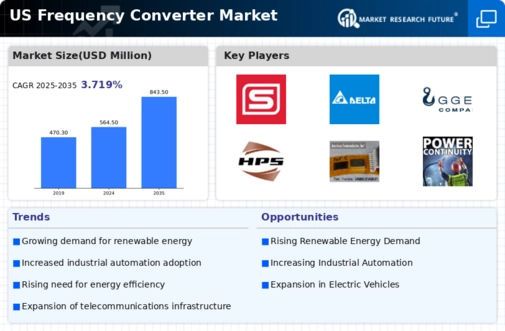Growth in HVAC Systems
The frequency converter market is benefiting from the growth of heating, ventilation, and air conditioning (HVAC) systems in the US. As energy efficiency regulations become more stringent, there is a heightened focus on optimizing HVAC systems to reduce energy consumption. Frequency converters are essential for controlling the speed of motors in HVAC applications, leading to improved energy efficiency and reduced operational costs. The HVAC market is projected to grow at a CAGR of 6% through 2027, which will likely bolster the frequency converter market as manufacturers seek to integrate these devices into their systems to meet regulatory requirements and enhance performance.
Rising Demand for Automation
The frequency converter market is experiencing a notable surge in demand due to the increasing automation across various industries in the US. Automation enhances operational efficiency and reduces labor costs, prompting manufacturers to invest in advanced technologies. In 2025, the market for automation solutions is projected to grow by approximately 15%, which directly influences the frequency converter market. These devices are essential for controlling motor speeds and improving energy efficiency in automated systems. As industries such as manufacturing, oil and gas, and transportation continue to embrace automation, the frequency converter market is likely to expand significantly, driven by the need for precise control and reliability in operations.
Increased Focus on Industrial IoT
The frequency converter market is influenced by the growing emphasis on the Industrial Internet of Things (IIoT) in the US. IIoT enables real-time monitoring and control of industrial processes, which often requires the integration of frequency converters for optimal performance. These devices facilitate the precise control of machinery and equipment, enhancing productivity and reducing downtime. As industries increasingly adopt IIoT solutions, the demand for frequency converters is expected to rise. The IIoT market is anticipated to reach $500 billion by 2026, indicating a substantial opportunity for the frequency converter market to capitalize on this trend and provide essential components for connected industrial systems.
Regulatory Support for Energy Efficiency
The frequency converter market is likely to benefit from regulatory support aimed at promoting energy efficiency in the US. Government initiatives and policies are increasingly focused on reducing energy consumption and greenhouse gas emissions, which encourages industries to adopt energy-efficient technologies. Frequency converters are recognized for their ability to enhance energy efficiency in various applications, making them a key component in meeting regulatory standards. As more companies strive to comply with these regulations, the frequency converter market is expected to see increased demand. The implementation of energy efficiency programs is projected to save the US economy over $1 trillion by 2030, further driving the adoption of frequency converters in various sectors.
Expansion of Electric Vehicle Infrastructure
The frequency converter market is poised for growth as the electric vehicle (EV) infrastructure expands in the US. With the increasing adoption of EVs, there is a rising need for efficient charging solutions, which often incorporate frequency converters. These devices play a crucial role in converting power to the appropriate frequency for charging stations. The US government has set ambitious targets for EV adoption, aiming for 50% of new vehicle sales to be electric by 2030. This shift is expected to create a substantial demand for frequency converters, as they are integral to the operation of EV charging systems, thereby driving growth in the frequency converter market.

















Leave a Comment